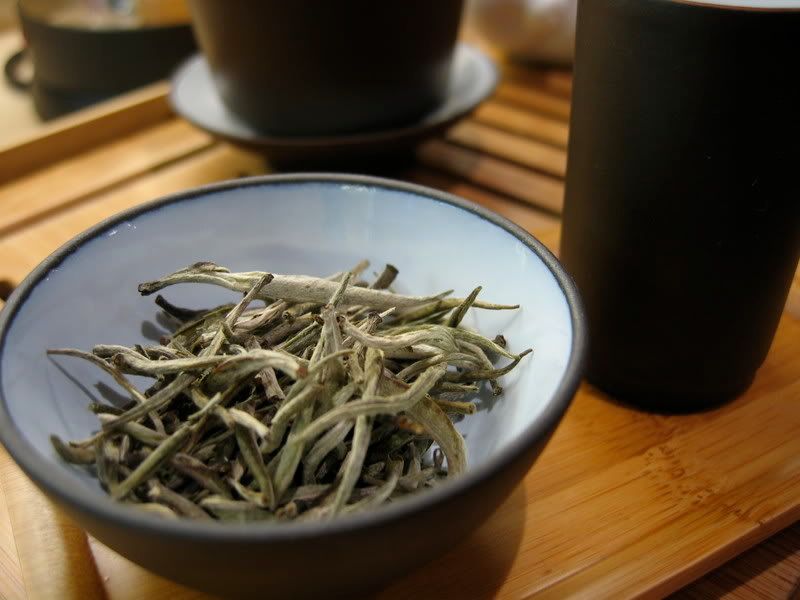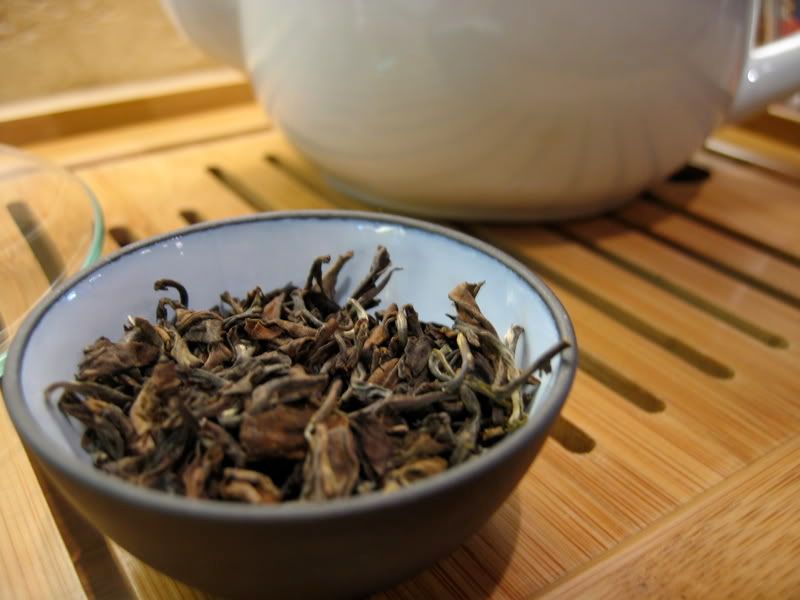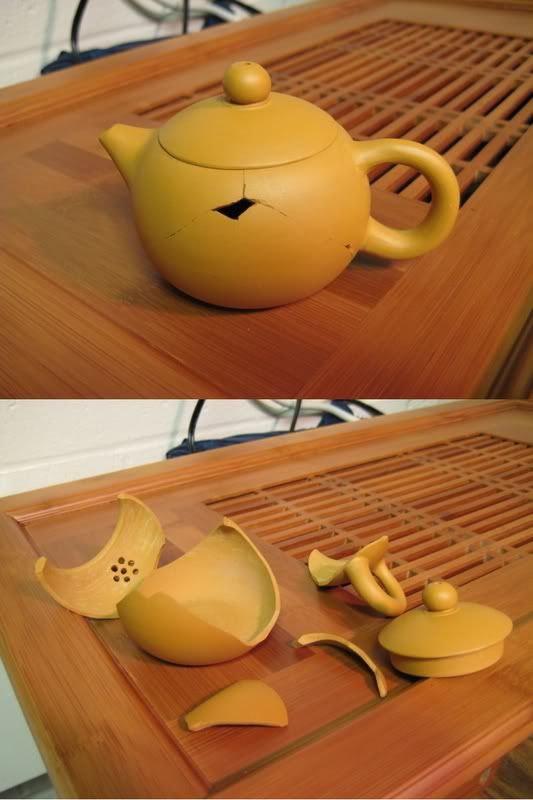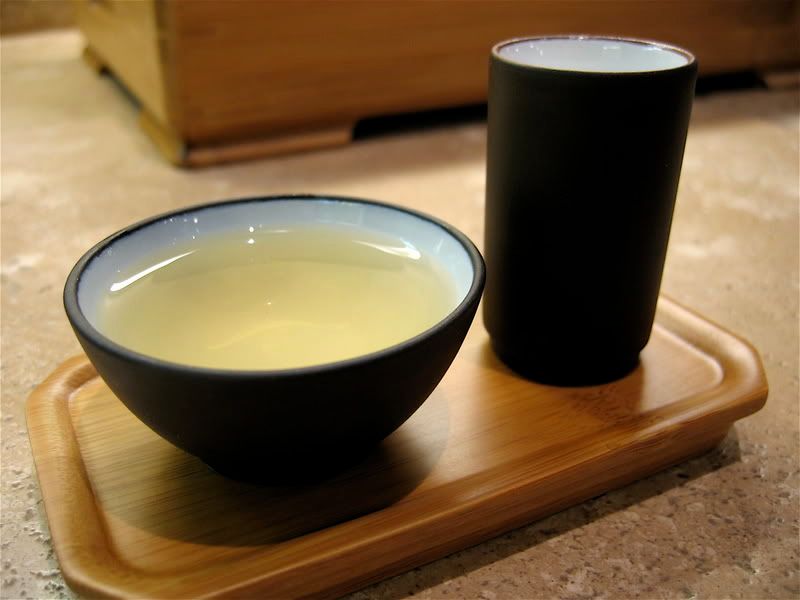These reviews are part of a
T Ching Online Tea Tasting, much like
the one I participated in previously. Thank you to T Ching for these teas. For a minimal $3 shipping charge, I received around 20-25g of each tea, which is quite a gift. It was also quite fortunate since it took quite a few tries to figure out the Meghma oolong (though I still haven't really gotten the hang of it). The focus of this tasting seems to be on unconventional teas from the Indian subcontinent, which seems to be an underrecognized genre in the tea blogging community. Anyway, without further ado, I present the Kashanganj Snow Bud and Meghma Nepalese Oolong.

Class: White
Origin:
Doke Organic Farm, Kashanganj, India
Year: ?
Vendor:
Lochan Tea Ltd.Price: $9.30 (100g)
Verdict: 6.5/10
Dry Leaf:I don't know a lot about the different styles of snowbud, but to my untrained eye these leaves are quite pretty and reminiscent of silver needle (bai hao yin zhen). Unfortunately I have a head cold right now, so my olfactory senses are limited and I can't really pick up on any dry leaf aroma. Nevertheless, this tea is looking good so far.
 Parameters:
Parameters:3.1g dry leaf; 170°F good tap water; 90s, 150s, 180s
Liquor:Not surprisingly, the liquor was nice and light. It reminded me of a light, sweet first flush Darjeeling, with a bit of a dancong-like perfumey astringency in the second infusion. The aroma cup initially smells of white sugar and vanilla, which develops into a very strong vanilla cake frosting aroma in the second infusion. By the third infusion, the liquor tasted like little more than sweet water. I probably could have given a fourth infusion more time to extract more flavor, but I felt that I had already gotten a good impression of the flavor so I didn't bother. I'm not much of a white tea fan since discovering the vast range of oolongs out there, but I can still appreciate the good quality of teas like this.
 Wet Leaf:
Wet Leaf:I know nothing about how wet white tea leaves/buds should look, so I won't even bother trying to analyze them. :) Still, here's a picture if you'd like to take a gander for yourself.
Overall Impression:White teas aren't my favorite, but I liked this one. It had good flavor, and there was nothing offensive about it. The dancong-like edge was just enough to make me think, "hmm... interesting," and earned this tea a solid
6.5/10.

Class: Oolong
Origin: Meghma Estate, Nepal
Year: 2007
Vendor:
Lochan Tea or
The Simple Leaf (sold as "Honeybee")
Price: $7.00 (100g)
Verdict: 4/10
Dry Leaf:Looks almost exactly like an Autumnal Darjeeling, and smells similar too. The leaf color varies from near-white to dark brown, common in teas of this region (though I would think it has far more to do with processing than terroir). Pretty!
Parameters:Oh boy. I've tried three different methods for brewing this tea: gongfu with long infusions (30+ seconds), European style with a big-honkin' cheap teapot, and gongfu with short infusions (10-15 seconds). Gongfu with long infusions was absolutely dreadful, and left me feeling a bit sick. Clearly, this tea is not meant to be brewed this way. I later tried brewing it European style (4g leaf; 8oz off-boiling water; 2:30, 1:00), and had more success. I tried gongfu one more time with shorter infusions, and got better results than the first attempt, but I couldn't seem to keep the infusion times short enough to enjoy the tea.
 Liquor:
Liquor:During my gongfu attempts, the liquor was extremely woodsy tasting, and not in a good way. If I had to describe the woodsy flavor, I would say it's like a very insipid and alkaline thyme, but I'm not sure if that really makes any sense. When I brewed it European style, the liquor was much more similar to an Autumnal or second flush Darjeeling black tea (though its status as a black tea is
debatable). Though there is still some woodsy flavor, it is much more subdued and a bit interesting. Perhaps if I hadn't already tasted it in concentrated form, I would have found it enjoyable and intriguing. At any rate, I found the second infusion to be particularly nice— no woodsy flavor, and a sweet fruitiness characterized this brew.
 Wet Leaf:
Wet Leaf:I was actually quite pleasantly surprised by the wet leaves of this tea. As you can see in the picture, there are many whole leaves and some intact leaves/bud/stem complexes. This tea certainly appears to be hand-picked. The leaves are a dark brown color, indicating a near-black tea level of oxidation.
Overall Impression:While I can certainly see that this tea has been picked and processed with care, I simply didn't like it. Frankly, I felt a bit sick after my last gongfu attempt, which definitely does not earn it high marks. Still, I can't help but think that it's the Indian and not the arrow (yes, I realize the irony of using the word Indian in this context, but you know what I mean). Even my best results tasted lackluster compared to a good second flush Darjeeling, and after reading
outstandingly positive comments by Phyll, I get the feeling I'm just brewing this wrong, so I can't give it an awful grade. So, instead, this tea gets a
3/10. I'm sure it gets better than this, but if it's this hard to get right, I don't think it's worth it.
Conclusion:While I enjoyed the teas in the last T Ching Tea Tasting more, it's hard to whine about free tea. I had been curious about Indian/Nepalese oolong for some time now, and even though I may not have had the best experience, it was still worthwhile. The real dark horse winner in this tasting was the Doke white tea— I didn't expect much but I actually liked it quite a bit for a white tea. Once again, thanks to the great people at
T Ching!
 ...is the devil's workshop. Ever since Adrian and I had a conversation about making the gong fu tea ceremony more reflective of our own culture and less of an imitation of Chinese culture, I've been trying to come up with something, nay, *anything* that could be incorporated from our traditions. Then I found my propane torch (originally purchased for making crème brulée), and thought "Hmm... now what's more American than setting fires and blowing sh*t up?"
...is the devil's workshop. Ever since Adrian and I had a conversation about making the gong fu tea ceremony more reflective of our own culture and less of an imitation of Chinese culture, I've been trying to come up with something, nay, *anything* that could be incorporated from our traditions. Then I found my propane torch (originally purchased for making crème brulée), and thought "Hmm... now what's more American than setting fires and blowing sh*t up?"















